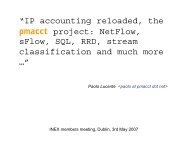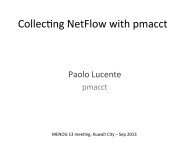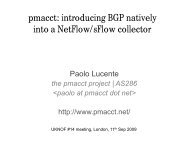pmacct: steps forward interface counters
pmacct: steps forward interface counters
pmacct: steps forward interface counters
You also want an ePaper? Increase the reach of your titles
YUMPU automatically turns print PDFs into web optimized ePapers that Google loves.
B. Inside the Plugins<br />
Each plugin reads the packed buffers - containing the aggregates - sent by the Core process from its<br />
communication channel. The reception is quite straight<strong>forward</strong>: the plugin blocks until the arrival of new data<br />
is signalled through the OOB channel; once a new buffer is ready to be processed, the aggregates contained into<br />
it are processed sequentially. Then, before going to sit again, waiting for a new signal, the plugin will check<br />
whether a new buffer has already arrived in the meanwhile; if this is the case it will get processed immediately.<br />
The plugins are differentiated by the backend they use to store data. The following sections will present an<br />
overview of the In-Memory Table (IMT) plugin and the SQL one 1 .<br />
1) the In-Memory Table (IMT) plugin: stores aggregates into a memory structure, organized as an hash table.<br />
Such table is divided in a number of buckets and aggregates are direct-mapped to a bucket by the mean of<br />
a modulo function. Collisions in each bucket are solved building collision chains, organized as linked-lists.<br />
An auxiliar structure, a LSU cache (Last Recently Used), is provided to speed up searches and updates into<br />
the main table. The LSU saves last updated or searched element for each bucket: when a new operation on<br />
the bucket is required, the LSU cache is compared first; if it doesn’t match, the collision chain gets traversed<br />
instead. Memory is requested from the underlying operating system in large chunks, called memory pools,<br />
to limit as possible the bad effects (e.g., trashing) that could derive from the dispersion through the memory<br />
pages of much more frequent tiny allocations. Memory pools are tracked via a linked list of descriptors to ease<br />
maintenance operations such as freeing unused memory.<br />
Data stored into the memory structure can be accessed by a client tool communicating with the daemon<br />
through a Unix Domain socket. The queries may be atomic (they contain just a single request) or batch,<br />
allowing a single query to encapsulate up to 4096 requests. The available query types are ’bulk data retrieval’,<br />
’group data retrieval’ (partial match), ’single entry retrieval’ (exact match) and ’erase table’. Additionally both<br />
partial and full matches may supply a request for resetting the <strong>counters</strong> for the matched entries. The client query<br />
is evaluated by the plugin: requests that need just a short stroll through the memory structure are served by the<br />
plugin itself, the others (for example batch queries or bulk data retrieval) are fulfilled by a new process spawned<br />
by the plugin. Moreover, locks have been implemented to guarantee a successful cohesistence of long-lived<br />
queries and mutual-exclusive operations like full table erasure. Some batch queries may be fragmented by the<br />
operating system because exceeding the actual socket size. They will require a reassembly process for which is<br />
in charge the plugin as soon as it receives a \x4 End of Message placeholder. Whether an incomplete message<br />
is received, it is discarded when the associated timeout expires.<br />
2) the SQL plugin: stores aggregates into a direct-mapped cache, organized as an hash table. Such mapping<br />
is computed via a modulo function; if the bucket already contains valid data, the conflict is solved with the use<br />
of collision chains: the chain gets traversed and whether it does not contain any unused element, a new one<br />
is appended at the tail. New nodes are allocated exploring two chances: if any node has been marked stale (it<br />
happens when an allocated node is unused for some consecutive timeslots) it’s reused by unlinking it from its<br />
1 As today, two distinct SQL plugins enable <strong>pmacct</strong> to operate with MySQL and PostgreSQL databases. However from the perspective<br />
of this document, this difference is not relevant. This is because we will refer to a generic SQL plugin.







